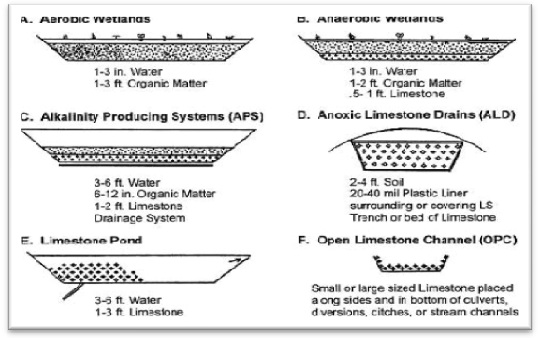 Treatment of AMD: Acid mine drainage sometimes forms when certain minerals in the soil and rocks
around mines are exposed to weathering processes during mining. These exposed minerals release their
contents into creeks causing them to become acidic. This kind of pollution damages aquatic life and
makes the water useless or harmful for others who depend on it for recreation or drinking water.
Treatment of AMD: Acid mine drainage sometimes forms when certain minerals in the soil and rocks
around mines are exposed to weathering processes during mining. These exposed minerals release their
contents into creeks causing them to become acidic. This kind of pollution damages aquatic life and
makes the water useless or harmful for others who depend on it for recreation or drinking water.
Today, coalmining and other industries use very expensive chemicals
(active treatments)
to treat these contaminated waters.
There are also less expensive methods known as (passive treatments)
that can help improve our rivers and streams.
Passive treatment methods are used most often for treating pollution from abandoned mines (prior to SMRA-1977)
but the methods are used in other situations as well.
Tools and things you will need
- Acid water from a creek
- Bottles with caps
- Cobble or other natural objects
- Compost
- Gloves
- Leaves
- Litmus paper
- Limestone
- Pine needles
- Rubber boots
Note: You will need large enough bottles for each object you plan to test.
What to do?
- Find an acid stream by using litmus paper to measure the pH.
- Collect the water in bottles.
- Add one natural material to each bottle. Measure the initial pH.
- Label each bottle and write down its pH.
- Every few days for about two weeks, measure the pH to see what happens in each bottle. Write down the results.
What did you see?
- What materials decreased the pH of the water?
- What materials increased the pH of the water?
- What materials caused solids to form at the bottom of the bottles?
- What colors were the solids?
- Did one of your experiments change acidic water to neutral?
What did you conclude?
- What natural materials do you think can be used to treat acid mine drainage?
- Can you create a treatment system using these natural materials?
- What are your conclusions? "Write down what you think."
[Learn more...]